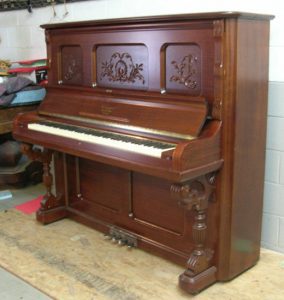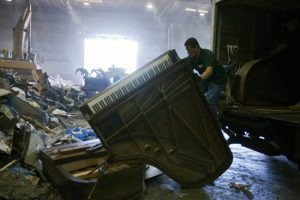
First, we got some experts to separate into manageable pieces. Next, we sought advice about how to move its heaviest parts. Then, I rented a cube van to move all the pieces. But we left the toughest challenge to the last – how we were going to move its huge sounding board down a set of stairs, across a floor, onto the front porch of our rental apartment and into the back of the cube van.
We actually found a set of heavy ropes and pillows to try to ease the heart of our upright piano – its the massive interior sounding board – down the stairs gently. Problem was, none of us could keep the hundreds of pounds of Baldwin piano sounding board from rumbling down the stairs. And when it got away on us, it slid down the stairs out of control, until it hit the wall at the base of the staircase with a thundering crash.
“Baaaannnng!” rattled the sounding board. And it resonated in that wall for a good minute after the collision.
Miraculously, nothing broke, except part of the plaster wall the sounding board hit. Otherwise, once we managed to pry the sounding board loose, transport the entire piano to its new home and reassembled its various pieces, unlike Humpty Dumpty, our Baldwin was a good as new. And up until the day we sold it to yet another family whose kids (like us) were going to learn to play scales, sonatinas and “Twinkle Twinkle” on it, that Baldwin gave my family and friends as much satisfaction as a piano could, in spite of how roughly we’d treated it. And I’m sure that’s been the life cycle of many an upright piano in this country for thousands of families for a century or more. That is, until now…

Last week, I heard a documentary called “End Notes” by Willow Yamauchi, on CBC Radio, and read a similar story in the New York Times by Daniel J. Wakin. Both feature stories reached the same conclusion. At warehouses and abandoned factory sites all over North America, specialists in piano disposal are bashing the unwanted uprights, apartment minis and baby grands into pieces small enough to then be disposed of in neighbourhood dumps or worse
“We bust them up with a sledgehammer,” Jeffery Harrington, the owner of Harrington Moving and Storage in New Jersey, told Wakin, “and then we toss the remains off the back of a truck into a landfill site.”

I don’t know about your family, but ours had a long, long love affair with upright pianos such as our Baldwin. My sister and I learned to play scales, suites and arpeggios on it. We practised and sweat over those ivory keys enough to squeak through countless Royal Conservatory piano exams. We played “Chop Sticks,” “Heart and Soul” and “Happy Birthday” a million times on its keys. But more than that, we learned the value of melody, harmony, forte and piano as well as life lessons such as disciplined practice, working alone and living up to our piano teachers’ expectations. And that old upright – through season after season of tuning and go out of tune – never stopped giving back.
“It’s almost a member of the family,” my parents used to say. And indeed, that upright stayed with us for a lifetime.
What’s more, pianos like ours gave communities all over North America enterprise, employment and prosperity. In the golden age of piano making – from the late 1800s to 1930 – factories in the United States and Canada churned out millions of them. Uxbridge turned out to be a hotbed of piano production in that era. With the industrial revolution and the railway, came the Uxbridge Cabinet Organ Manufacturing Company, with $20,000 in capital funding and 300,000 feet of lumber, wrote Allan McGillivray in his book Tales from the Uxbridge Valley.
Oh, the UCOMC also churned out furniture and coffins, but production was sophisticated enough to attract one A.S. Hardy, a piano tuner and composer from New Hampshire, McGillivray pointed out. And piano cabinets made of birch, mahogany and bird’s-eye maple came off the line in record numbers into the 1880s. According to the National Piano Manufacturers Association (in the U.S.) nearly 365,000 were sold at the peak of production in 1910. In 2011, only 41,000 were sold.
The subject of what to do with the half-sized upright in our daughter’s home came up over Thanksgiving dinner on the weekend. I winced at the notion that one day it might have to be taken away as discarded waste. The image painted in that Times article, haunts me yet. A company called Beethoven Pianos, operating a 34,000-square-foot warehouse in the Bronx, it reported, has scores and scores of uprights awaiting disposal.
“In wintertime we burn them,” owner Carl Demler told the reporter. Then, as another was broken apart and tossed into a metal stove for incineration, he added, “Ashes to ashes.”
And nobody offered a musical requiem, because the instrument on which to play it was in the fire at the time.